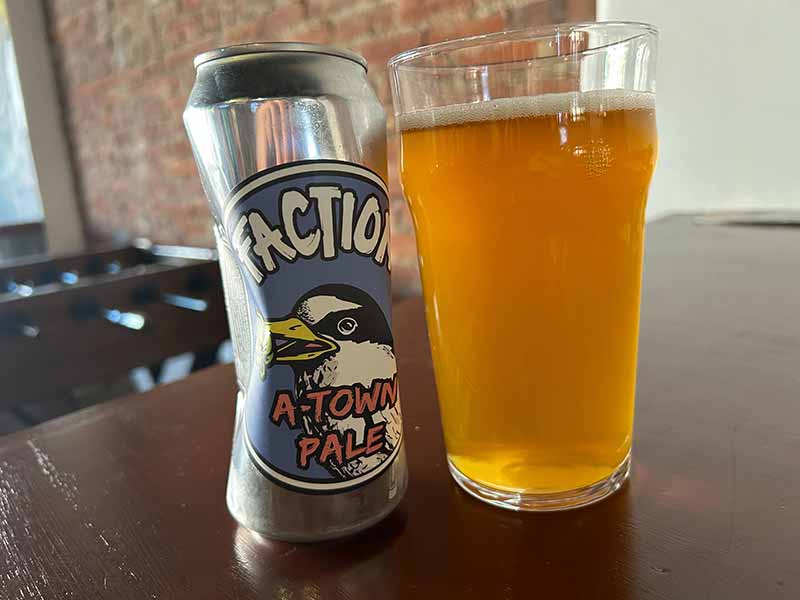
Hop-forward beers dominate the craft beer industry from a consumer perspective, as evidenced by IPAs topping the charts of the latest Untappd Year in Beer. Whether it’s hazy, American IPA, cold IPA, double, or triple, consumers are throwing them back in droves. Another hop-forward style, albeit a lighter version, American pale ale, could be worth adding to your brew schedule to round out your menu.
We chatted with experts in the style from Faction Brewing and Dogfish Head Craft Brewery to understand the American pale ale’s top considerations, challenges you can face, what hops work best, and what ABV to use to finish the beer.
(Above photography courtesy of Giovanni Albanese Jr. | Next Glass)
What We’ll Cover in This Piece:
Affordable, Industry-Leading Brewery Software
How Do the Experts Define American Pale Ale?

Photography courtesy of Dogfish Head
Dogfish’s Head Manager of R&D Brewing, Bryan Selders, says the best American pale ale is a balanced beer with bold American hops, a toffee-like crystal malt, and slightly fruity American ale yeast.
“They appear in the glass, often with a faint veil of hop haze, aromatic with notes of grapefruit, orange, and pine, firmly bitter with just enough malt sweetness to hold it all together,” Selders says. “They finish clean and dry, demanding another sip.”
Faction Owner and Brewer Rodger Davis says the American pale ale is all about big hop aroma and lower alcohol content.
“A lot of people think there is a line crossed when it’s 5.2% ABV and hopped aggressively, that it should be an IPA,” Davis says. “I don’t think hops have anything to do with it. I think alcohol does. So I am looking for big hop aroma and medium-to-low alcohol.”
What Differentiates American Pale Ales from Other Global Ones?
Graphic courtesy of Derek Campos, Senior Graphic Designer, Next Glass
It’s all about the potency of the hops.
“English ones are easy to pick apart because of the hops,” Davis says. “New Zealand and [other] international pale ales blur lines because the hops are so much different from the U.K. hops.”
Davis adds that the overpowering pungency of Pacific Northwest hops sets American pale ales apart from all other variations of the style.
Of all of Faction’s pale ales, including Southern Hemisphere, English, and Pacific Northwest versions, the American pale ale sells best.
Selders concurs with Davis that the bold hop aromas of American hops really set the stage for the American pale ale. But that’s not the end all be all.
“There are other characteristics that differentiate them from other examples from around the world like [domestic] yeast and malt,” Selders says. “But hops, by far, really set them apart.”
What Are the Top Considerations When Brewing American Pale Ale?

Photography courtesy of Sierra Nevada Brewing Company
Selders says it’s all about balance and restraint.
“[That is] critical in making a world-class American pale ale,” Selders says. “It’s quite tempting and can be very easy to go overboard with hops or crystal malt to make an impression, but the true mark of mastery of the style lies in knowing when to say when.”
Selders notes that when it comes to best practices, yeast health and controlling fermentation are infrequently mentioned, but they “should not be overlooked as they can make or break your American pale ale.”
Davis says to hone in on two main things: a dry finish and a big hop aroma.
“Even when we do the British Pale, we still hop it like it would be an American pale, as opposed to how they do them in the U.K.,” Davis says.
Davis says they treat an American pale ale old-school, mashing in around 149 degrees Fahrenheit to get a really dry beer.
“We do four hot-side hop additions and one in the fermenter,” Davis says. “We play around with that and knockout a hop addition on the hot side, while others at the end of the boil and whirlpool, and dry hop the crap out of it.”
Whatever you do, Selders says to aim for drinkability.
“Target a relatively high RDF and low pH. This will enhance drinkability and help those American hops pop,” he says. “Pitch enough healthy yeast to do the job and give it the right amount of oxygen to allow it the best chance of producing great flavor.”
Selders adds, “Keep the fermentation cool and be sure to allow enough time for some crucial warm conditioning and at least a week of cold conditioning.”
What Challenges Can You Run Into with American Pale Ale?
Selders keeps it short and to the point.
“It is very easy to take an American pale ale into IPA territory,” he says, “Resist the urge.”
Selders says that adding too many hops early in the boil process will lead to over-aggressive bitterness in an American pale ale. Brewers should focus on formulating a recipe with a target IBU in mind.
“The challenge arises when deciding how [heavy] late hopping is to be, both in the whirlpool and in dry-hopping,” Selders says. “With whirlpool hops, it can be assumed that you’ll achieve eight to twelve percent utilization of alpha acids, so bitterness will increase with this type of hop addition and this should factor into the recipe formulation.”
Selders advises brewers to aim for achieving thirty-five to fifty percent of the beer’s total IBUs from the whirlpool addition.
“This will lead to a beautiful late-hop character,” Selders says.
And Selders says that dry hopping is not something he prefers in an American pale ale, but it can be done.
“Dry hopping detracts from the delicate balance that is so appetizing about a well-crafted example of the style,” Selders says. “If it’s to be done, keep it light and under a pound per barrel. In this type of beer, it should be an accent and not the whole show.”
Along the same lines, Davis says to balance the beer by monitoring your malts.
“You need to look for more balance,” Davis says. “We use crystal in most of our pales but not higher than three percent. And in most cases, we are at one percent, and in some, we don’t add any crystal malts.”
What Is an Ideal American Pale Ale Grist Bill?

Photography courtesy of Toppling Goliath Brewing Company
Davis says Faction is a single-infusion mash operation, focusing on 149 or 150 degrees Fahrenheit. For the grains, they keep it simple.
“We use standard Rahr two-row and anywhere between one percent to three percent crystal malts,” he says. “Everyday is C60, and most other pales, we use C45.”
Davis adds, “We’ve also played around with adding two-row and adding five pounds of chocolate malt to give it a little color.”
Selders has a similar approach to American pale ale grist, with a subtle difference from Davis.
“A classic American pale ale has a very simple grist of domestic two-row barley malt and three percent to six percent crystal malt: 40 to 80L,” Selders says, adding that mash temps depend on the brewery and finishing goals.
What Hops and IBUs Works Best in American Pale Ale?

Photography courtesy of Sierra Nevada Brewing Company
Selders and Davis keep pointing to hops as the crucial element of American pale ales. So, just how much is enough for an ideal take on the style?
“American pale ale is normally twenty-five to forty IBU,” Selders says. “Late hops in the kettle and whirlpool are essential for the best hop aroma and flavor.”
Selders adds, “Dry-hopping is optional, and if it’s to be done, do so lightly.”
Davis says Faction used to use the high-alpha hop Horizon but shifted to Simcoe for its bittering hop, which he says is a good replacement.
“We look for twenty BUs,” Davis says. “Our flavoring hops vary, but we use Mosaic, Simcoe, and Citra [a bunch]. Most pales get a Mosaic and Citra charge.”
He adds, “We’ve been using HBC 586 lately, and it’s a good hop. For the dry hop, we add anywhere from two and a half to four pounds per barrel.”
Davis says they’ve used other hops occasionally at Faction, including Apollo, Columbus, Ekuanot, and El Dorado.
What Is the ABV Sweet Spot for American Pale Ale
Selders says it’s a wide range you can play with, depending on the brewer and their goals.
“Anywhere from 4.5% ABV to 5.5% ABV is the sweet spot,” Selders says.
Davis says their range for IPAs begins at 6.5% ABV. Under that is a pale ale.
“We are between 5% ABV and 5.9% ABV,” Davis says of their American pale ale range. “And if we get to 6% ABV, we call it a strong pale.”
Two Great Examples of American Pale Ale
Davis says it’s hard to pick just one. Typically, Faction has anywhere from five to seven pale ales on at the taproom.
“I like them all,” he says. “I like the way we do them—big hop and lower alcohol.”
Davis adds, “But if I were to pick one, it’s The Penske File. It has a nice Mosaic aroma, and we cut that with Ekuanot in the dry hop, which makes us stand out among the Mosaic crowds.”
Dogfish Head previously made Faithful Companion, a 4.2% ABV American pale ale, which Selders says was one of his all-time favorite beers he brewed. The beer is made from two-row, 20L Crystal malt, and malted heirloom-variety corn.
“And it is perfectly hopped to fifteen IBUs with a healthy dose of Cascade late in the kettle and the whirlpool,” Selders says. “It is brisk and crisp; citrusy with just enough caramel and corn sweetness to provide delicate balance.”
He adds, “It finishes dry and is the proper foil for the demanding thirst of hard work. It’s as bougie as blue collar can get, but an honest day of work demands the highest caliber of refreshment.”



